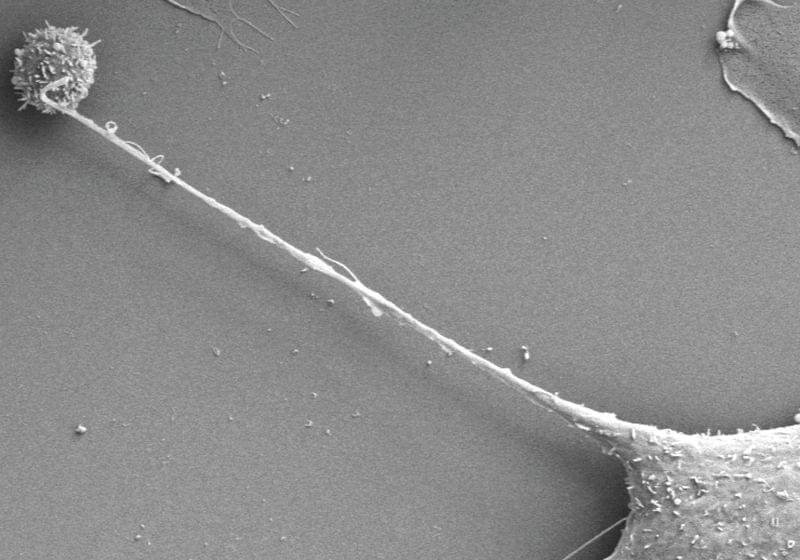Cisco Systems has rolled out fixes for a critical security flaw affecting Redundancy Configuration Manager (RCM) for Cisco StarOS Software.
Google researchers detail two zero-day vulnerabilities reported in Zoom client software and MMR servers.




Cancer cells send out nanotubes to suck mitochondria from immune cells, finds a November 18 study in Nature Nanotechnology. The pilfered organelles allow the cancer cells to replenish their power while weakening T cells—a finding that could lead to new avenues for assailing tumors.
“It’s surprising that the transfer of mitochondria happened between different cell types, intriguingly between immune cells and cancer cells,” writes cancer biologist Ming Tan of China Medical University in Taiwan, who was not involved in this study, in an email to The Scientist. While researchers have observed mitochondrial transfer between cells before, most cases occurred between two cells of the same type. “Moreover, the mitochondrial transfer appears to have a significant impact on tumor cells escaping from immune surveillance,” Tan adds. “This is exciting because [of] its potential therapeutic implications.”
See “Nanotubes Link Immune Cells”.
Your email address will not be published. Required fields are marked
Comment.


Pfizer CEO Albert Bourla on Monday said a vaccine that targets the omicron variant of Covid will be ready in March, and the company’s already begun manufacturing the doses.
“This vaccine will be ready in March,” Bourla told CNBC’s “Squawk Box.” “We [are] already starting manufacturing some of these quantities at risk.”
Bourla said the vaccine will also target the other variants that are circulating. He said it is still not clear whether or not an omicron vaccine is needed or how it would be used, but Pfizer will have some doses ready since some countries want it ready as soon as possible.

BERKELEY, Calif. 0, Jan. 20, 2022 — Atom Computing, the creators of the first quantum computer made of nuclear-spin qubits from optically-trapped neutral atoms, today announced closure of a $60M Series B round. Third Point Ventures led the round, followed by Primer Movers Lab and insiders including Innovation Endeavors, Venrock and Prelude Ventures. Following the completion of their first 100-qubit quantum computing system with world-record 40 second coherence times, Atom Computing will use this new investment to build their second-generation quantum computing systems and commercialize the technology.
“Atom Computing designed and built our first-generation machine, Phoenix 0, in less than two years and our team was the fastest to deliver a 100-qubit system,” said Rob Hays 0, CEO and President, Atom Computing. “We gained valuable learnings from the system and have proven the technology. The investment announced today accelerates the commercialization opportunities and we look forward to bringing this to market.”
With this new level of investment, the company will turn its focus to developing much larger systems that are required to run commercial use-cases with paradigm-shifting compute performance.

Mock seemed pleased with the outcome. “You could look at this and say, ‘O.K., the A.I. got five, our human got zero,’” he told viewers. “From the fighter-pilot world, we trust what works, and what we saw was that in this limited area, this specific scenario, we’ve got A.I. that works.” (A YouTube video of the trials has since garnered half a million views.)
Brett Darcey, who runs Heron, told me that the company has used Falco to fly drones, completing seventy-four flights with zero crashes. But it’s still unclear how the technology will react to the infinite possibilities of real-world conditions. The human mind processes more slowly than a computer, but it has the cognitive flexibility to adapt to unimagined circumstances; artificial intelligence, so far, does not. Anna Skinner, a human-factors psychologist, and another science adviser to the ACE program, told me, “Humans are able to draw on their experience and take reasonable actions in the face of uncertainty. And, especially in a combat situation, uncertainty is always going to be present.”

We search for the signature of parity-violating physics in the cosmic microwave background, called cosmic birefringence, using the Planck data release 4. We initially find a birefringence angle of β=0.30±0.11 (68% C.L.) for nearly full-sky data. The values of β decrease as we enlarge the Galactic mask, which can be interpreted as the effect of polarized foreground emission. Two independent ways to model this effect are used to mitigate the systematic impact on β for differen… See more.
We search for the signature of parity-violating physics in the cosmic.
Microwave background, called cosmic birefringence, using the Planck data.
release 4. We initially find a birefringence angle of $\beta=0.30\pm0.11$ (68%
C.L.) for nearly full-sky data. The values of $\beta$ decrease as we enlarge.
The Galactic mask, which can be interpreted as the effect of polarized.
foreground emission. Two independent ways to model this effect are used to.
mitigate the systematic impact on $\beta$ for different sky fractions. We.
choose not to assign cosmological significance to the measured value of $\beta$
Until we improve our knowledge of the foreground polarization.